In this article, I am going to teach you everything you need to know about Content Gap Analysis, and I am going to give you a step-by-step process to find the most profitable keywords for your website.
Also, you will get my Content Gap Analysis template to track all your competitors and keywords you have found and analyzed.
This unique keyword research strategy gives you a different way to find untapped keyword opportunities and steal the best keywords of your competitors. Thus, making your content marketing strategy more efficient, increase ROI, and raises profits.
What is Content Gap Analysis
Content Gap Analysis also called Keyword Gap Analysis is a process of analyzing current content inventory on your and your competitors’ website and then finding missing keywords and topics on your website to target in order to increase topic relevancy, organic traffic, and ranking for your website.
Content Gap Analysis is another keyword research method that helps you to uncover missing keywords on your website and discover keywords that drive your competitor’s organic traffic.
This keyword research strategy is especially effective because unlike traditional keyword research, where you need to come up with topics ideas and after that with subtopics ideas which can be often very challenging.
With Content Gap Analysis you only need to find the right competitors to get tons of great keyword ideas along with your competitors ranking.
And this is super helpful because if similar-level competitors can rank for those keywords, then you can too.
And don’t worry I’ll show you exactly how to find tens and even hundreds of competitors that are perfect for content gap analysis!
Why Do You Need Content Gap Analysis?
Content Gap Analysis is an excellent keyword research strategy especially if you are running out of keyword ideas as with this method all the hard work is done for you by your competitors.
Unlike traditional keyword research, with Content Gap Analysis you do not need to come up with the right low competitive seed keyword or general keyword to find keywords that you can rank for.
Content Gap Analysis is especially useful for smaller websites because rather than searching for hidden keyword gems on the large sites or using seed keywords and then hoping you can rank for the keyword, Content Gap Analysis can show you proven keywords that smaller websites are already ranking for in your niche.
With Content Gap Analysis you will be able to pretty accurately determine where you will be ranking once you publish your new content which is giving you the opportunity and capability to create only content that your website can rank for.
So, like this, you will maximize your marketing resources and focus only on the most promising keywords and topics that can drive organic traffic and leads for your business.
And there are so many more benefits to Content Gap Analysis, however instead of telling you that, let me show you how you can perform Content Gap Analysis for your website.
Content Gap Analysis SEO Tool
To perform Content Gap Analysis you will need to use an SEO tool with such capability.
Luckily, there are many different SEO tools you can use to perform Content Gap Analysis and if you are already using an SEO tool for your website, then you can use that.
However, if you do not use any SEO tool, then I can recommend you SE Ranking.
SE Ranking is an all-in-one SEO software with over 30 tools for every task in search marketing. The platform provides analytical data and monitoring features that help specialists, agencies, marketers, and business owners bring their websites to the top of the SERPs and stay there.

And compared to other SEO tools SE Ranking offers by far the best value for money which makes it available for specialists and companies with limited marketing budgets starting from as little as US$25 per month.

So if you want to give it a try, you can use my link here to get 14 days trial. Plus, I will be using SE Ranking throughout this video, so you can follow me along the way and learn how to use the tool effectively to boost your ranking.
However, if you are using another SEO Tool, then you can still follow me as I will be focusing on how to do Content Gap Analysis with any SEO tool. Only they might call the feature differently, but I believe your SEO tool still should have the features I am going to use here.
Or you can sign up for the 14 days trial as well and compare the tools to figure out which one is better for you. This I will leave it up to you.
Create Content Gap Analysis Template
Before we start, we need to create you Content Gap Analysis Template where you can track all your competitors and newly discovered keywords for your website.
Luckily, this is not difficult, and you can copy the one I am using and then modify it to your needs. Here is my content gap analysis template:

As you can see, I am tracking two different competitors. The same-level competitors are domains with similar domain trust like mine.
For example, if my domain trust is 20, then I consider competitors with domain trust between 10-40 as my same or similar level competitors, and anything above is high-level Competitors.

Also, you can see only two competitors for each level. However, this is only for the tutorial, and I do recommend you find at least 10 competitors for each level.
Trust me, this will give you plenty of keywords to choose from, so you can select only the most relevant and profitable keywords for your website.
Step #1: Find Your Competitors
The first step of Content Gap Analysis is to find competitors that are already ranking for similar or same keywords, but also for many more keywords than you want to target.
To do that, there is a number of different tactics you can use to find your competitors.
With that here are 2 proven ways to find competitors sites that are perfect for content gap analysis:
Technique #1: Perform Competitive Research on Your Website
The first technique to find the right competitors for content gap analysis is to perform competitive research on your own website to find competitors that share common keywords with you.
This is probably the best technique to find competitors and most of the SEO tools can give you your organic competitors based on common keywords.
With that, let’s fire up your SEO tool. In my case, I use SE Ranking.
First, I open up the SE Ranking Competitive Research tool, enter my domain, select my targeted location, and hit “Analyze”.

Here I will get information about the analyzed website such as the domain trust, organic & paid traffic, ranking keywords, traffic cost, and backlink profile. All this information gives me a high-level overview of the analyzed website and then I can easily navigate to different sections by selecting any of the displayed reports.
However, to find my competitors I will open up the “Organic traffic research” tab and select the “Competitors” report.
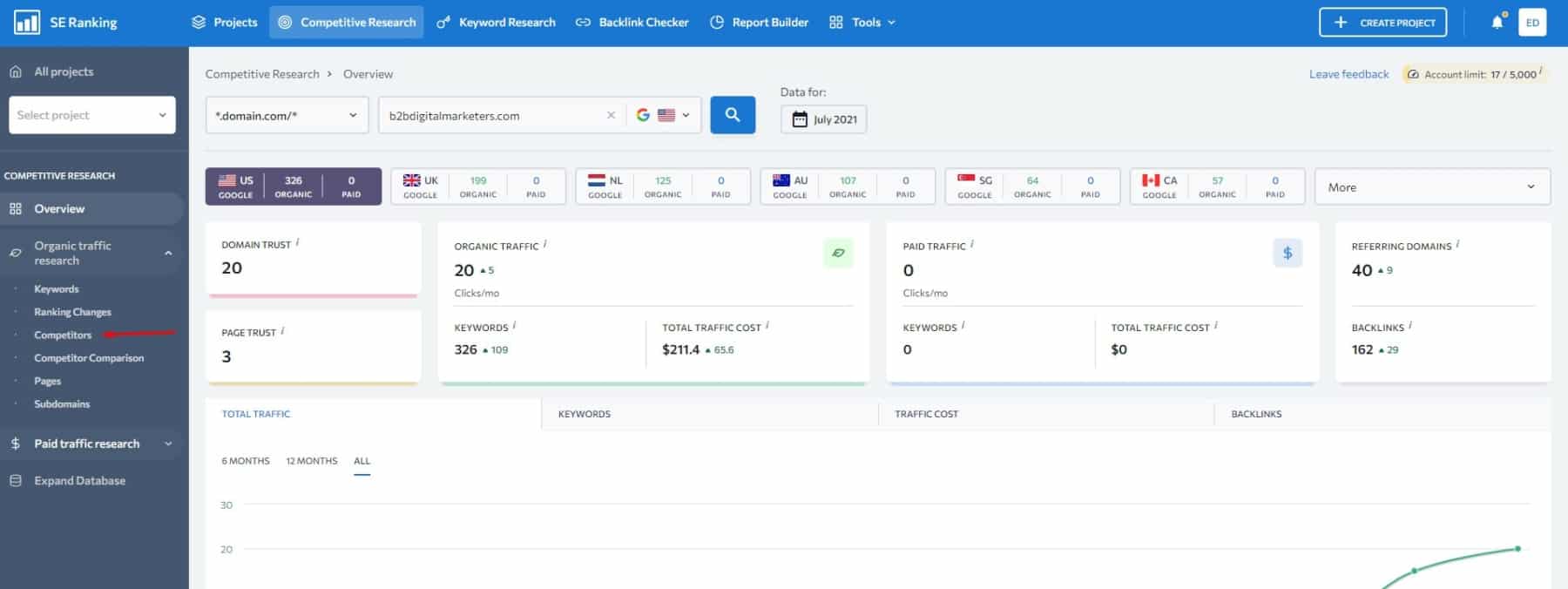
And here I have a list of domains that are sharing common keywords with me. However, just because they are ranking for the same keywords as me, it doesn’t mean it makes them the right competitor for Content Gap Analysis or even keyword research.

And in step #2 I will show you how to analyze and select the right competitors for your content gap analysis. However, for now, let’s move to the second method to find your competitors.
Technique #2: Find Your Competitor Competitors
The second technique to find your competitors is to find your close competitor competitors.
I recommend you use this technique if you do not have a website yet or you have just started and you got only a few pieces of content on your website.
Also, it is a great strategy to expand your list of competitors.
So, similarly to the first technique, I open SE Ranking Competitive research tool, however now I enter the domain of one of my competitors, select my targeted location, and hit “Analyze”.

Then I go to the “Competitors” report and like before I have the list of competitors of my competitor based on the common keywords.

As I said, you can use this technique if your website is too small or even if you want to generate more competitors within your niche. Now, I can do this for every single competitor you are seeing here.
I just click on one of the domains and it will open up the competitive report again for the different competitor and I can go to the “Competitor” report again.

This technique is great for outreach as well. For example, if you want to find potential guest blogging opportunities, you can use this technique as well.
Anyway, with that, once you have your competitor list, then let’s move to the second step.
Step #2: Analyze & Select the Right Competitors
The second step of Content Gap Analysis is to sort through the list and select the right competitors for your content gap analysis.
The thing is, just because you are sharing common keywords with other domains it doesn’t mean it is the perfect competitor to do a content gap analysis.
What you are searching for are domains that:
- Are focusing mainly on the topics that you want to target.
- They are mostly targeting keywords and long-tail keywords within your niche.
- Ranking for a lot of keywords in your targeted niche that you don’t.
That’s why it is important to know what topics you want to target in the near future to determine the right competitor. Because I assume you have limited marketing resources. Therefore, you need to have laser focus content marketing strategy for your website to create topic relevancy.
With that let me show you how to analyze your competitors and select only the right competitors for your content gap analysis.

As you can see, I am sharing a lot of common keywords with the domain g2.com. So, to determine if that’s the right competitor or not, I open the domain in the Competitive Research tool and also in my browser.
In the competitive research tool, I can see the total number of keywords my competitor is ranking. And to see what keywords they are ranking for I open the “Keywords” report.

And here I have the list of all keywords my competitor is ranking for along with other additional helpful information. And on the first view, I can see they are ranking for keywords that are way outside of the targeted topic.

So let me have a look at their website to see what their targeted niche is. And by browsing their homepage, blog posts, category pages, and others I can see, that they are focusing on the overall SaaS software industry, specifically on reviews.
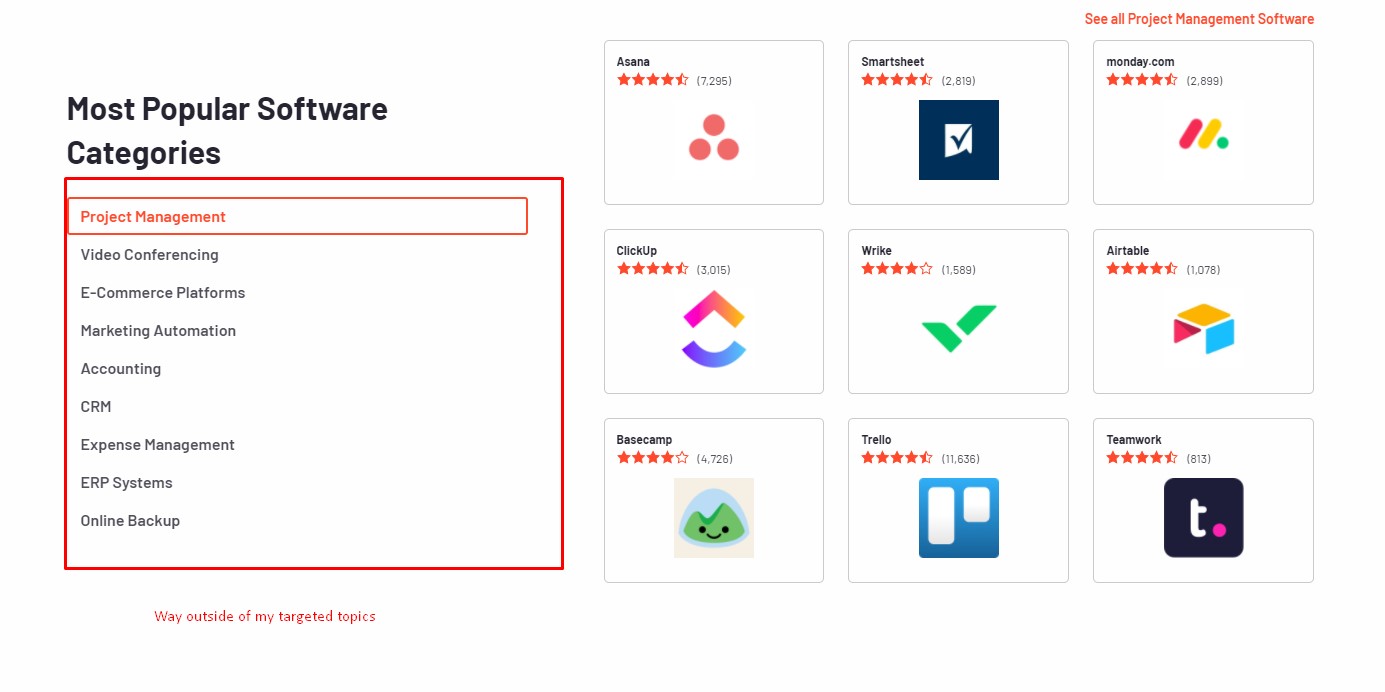
Therefore, this is a NOT good competitor as I am focusing only on SEO, Content Marketing, and Lead Generation.
And because this is a massive website that also targets SEO tools, content marketing, and lead generation tools, it’s no wonder they have pieces of content around this topic and that’s why we share common keywords.
However, they are way outside my targeted niche so I will not select them for Content Gap Analysis, and let’s analyze another competitor.
Another competitor that is sharing a lot of common keywords with me is webfx.com. So, the same way like before I open up their keywords report in SE Ranking and their website in the browser. And just by looking at their keywords, I can see, that they are focusing very much on the same topics as me.
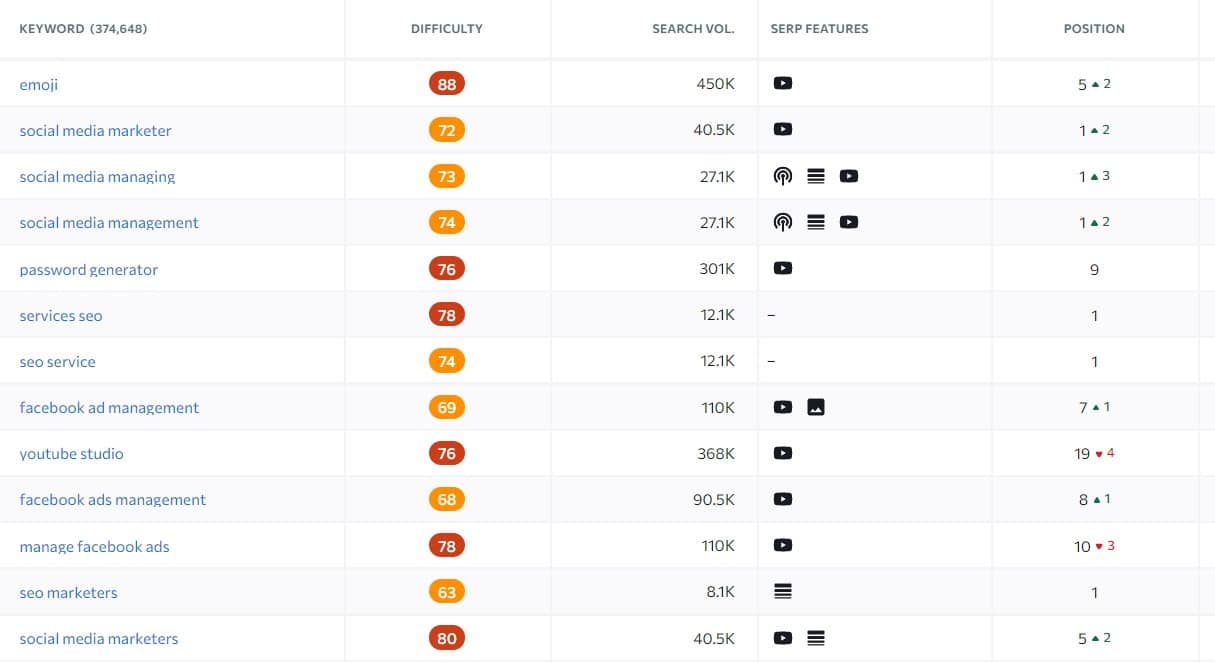
And by going through their website pages, I am seeing they are an SEO company that is focusing on SEO & Lead Generation, eCommerce, and UX & website development which is very closed to my targeted topics.

Therefore, they are a great example of high-level competitors for content gap analysis, so let’s pop them into the content gap analysis template.

However, what you often experience when searching for high-level competitors is that they often cover more topics in your niche that you don’t plan to write about yet. And that is fine as long as you find a competitor that is mainly focusing on topics you want to establish topic relevancy it will work.
Alright, so the exact same way I will find another high-level and same-level competitor. As I said, I only have two for each level, but I do recommend you to find at least ten for each level to find the most profitable and suitable keywords for you.
So, here is my updated content gap analysis template with all the competitors that target mainly the same topics I want to target too.

Step #3: Find Missing Keywords & Topics
Step #3 is to find the content gaps or missing keywords and topics on your website based on your competitor’s ranking keywords.
And to do that I will open up the “Competitor Comparison” tool or I can just click on the number in the “Missing Keywords” column.
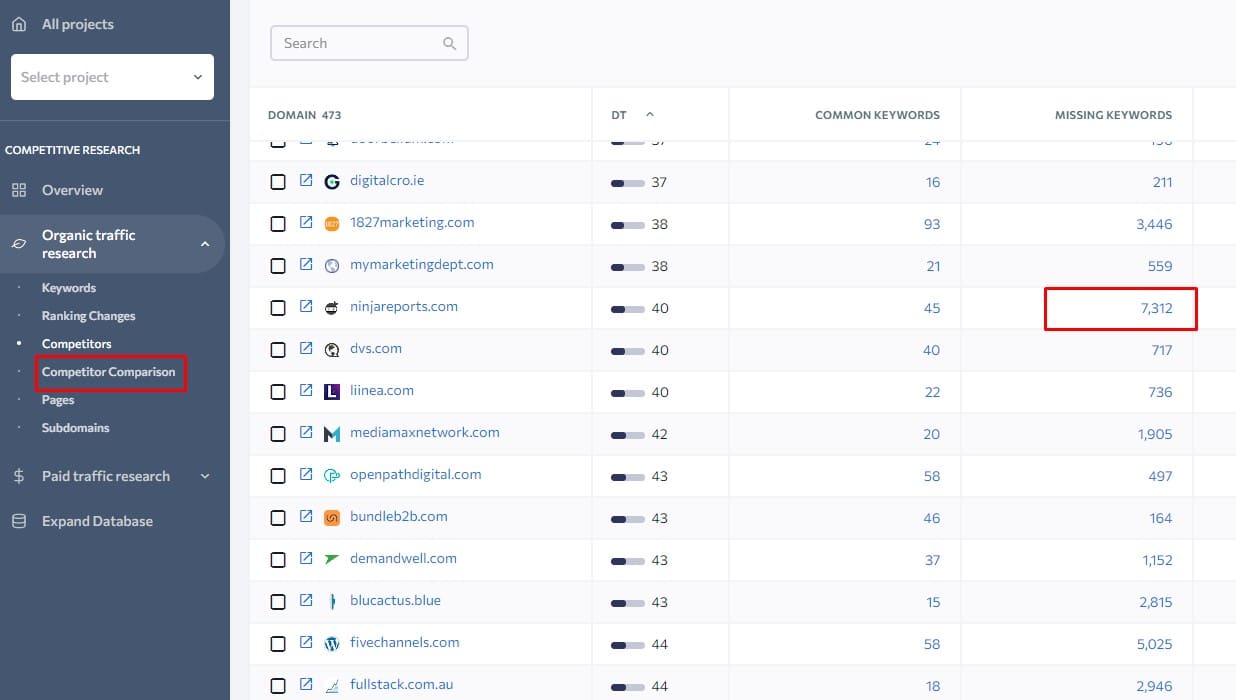
And here I will get the list of my missing keywords along with additional information to the keywords. Now based on the level of competitor I am analyzing I will take a different approach.

So let me show you two techniques to find keywords or content gaps on the same level and high-level competitor domain as they slightly differ the way how you should search for missing keywords.
Technique #1: Same Level Competitor
Let’s first search for keywords on the same-level competitor domain.
In this example, I have found a competitor ninjareports.com with a domain trust of 40.
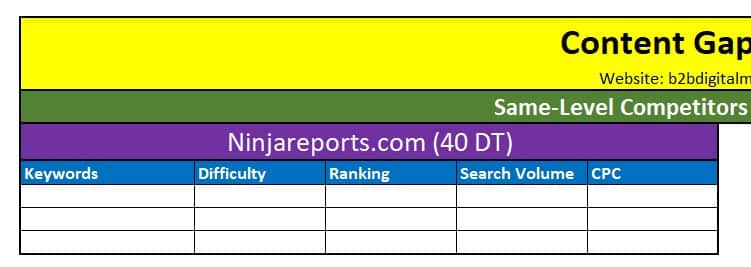
Now, because this is a domain with similar domain trust as me, I want to see their unique keywords or keywords that they rank for, but I don’t.
However, I want to also see their ranking for the particular keyword. And the reason why is because if they can rank for the keyword in the first page of search engine result pages, then I have a chance to rank there as well with a little bit of link building.
So, to get this information, I will change to the “Unique Keywords” report and select my competitor domain to see their unique keywords and not mine. And woala here I have a list of already proven keywords.

Now I only have to scan the keyword list and find keywords with ranking positions between 1-10 or even 1-20 is fine with me. As I said, I might need to do link building and competitor backlink analysis anyway.
However, because there are over 7,000 unique keywords on the list, I can just export the data into an excel spreadsheet and set a filter for the “position” column between 1-10.

And just like this, I have a nice list of keyword ideas that my same-level competitor is ranking for and as I said, these keywords are already proven that smaller sites can rank in top positions.
So, do this for all of your same-level competitors and you will get a nice list of keyword ideas and content gaps for your website.
Technique #2: Both Level Competitor
And now let’s have a look at the second technique to find keywords. This technique you can use for both level competitors.
So, same as before I open the SE Ranking Competitor Comparison tool, and let’s enter one of my high-level competitors and hit analyze.
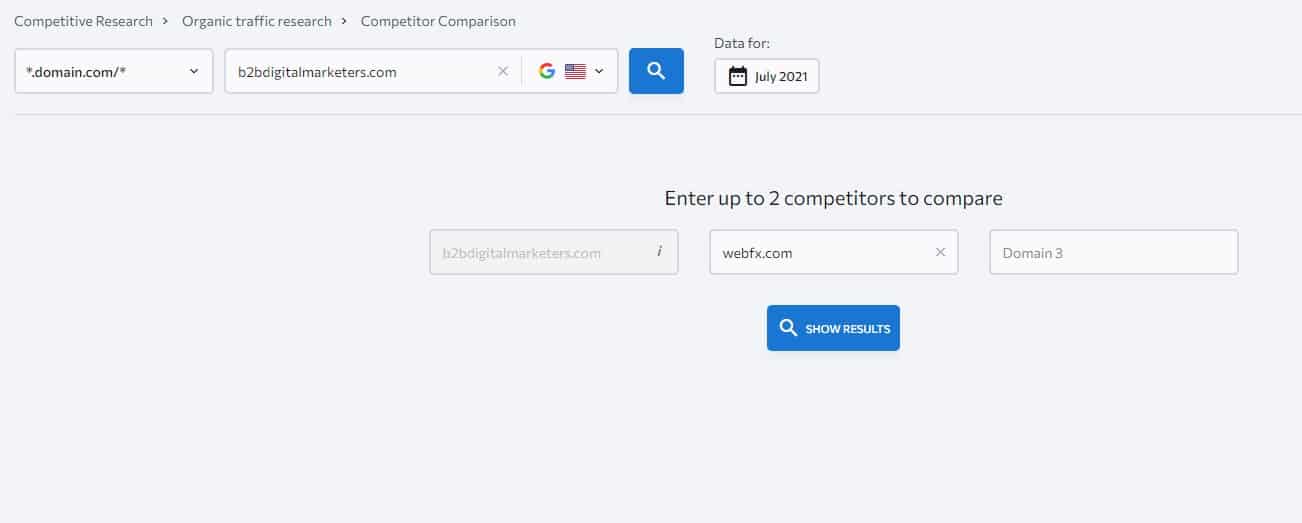
Now, I will select the “Missing Keywords” report and select my domain. And as you can see, I am missing almost 400,000 keywords on my website that my competitors’ website is ranking for.

That is way too many keywords to go through them manually. So, I can set some filters to improve the quality of display keywords. So let’s set the “keyword difficulty” filter to something low like 40 and then “search volume”. And now I am down to about 400 missing keywords.
However, this is not mandatory, and you can keep the keyword difficulty the same if you are just searching for keyword ideas to target to increase topic relevancy.
So, these are the two techniques you can use to find missing keywords and topics for your website.
Step #4: Missing Keyword Analysis
The fourth step in Content Gap Analysis is to analyze the keywords you have just found using the two techniques I have just showed you.
Now to analyze your missing keywords will pretty much depend on your preferences, targeted niche, search volume in the targeted niche, your domain trust, and many more aspects.
However, analyzing the right keywords is an essential part of your SEO strategy for B2B or B2C as well as for your content gap analysis.
So, when you want to analyze your keywords, you can measure the quality of keywords by using the keyword analysis checklist:
- Keyword Difficulty: It shows an estimated difficulty score. The higher the number the harder it is to rank for the keyword.
- Search Volume: These metrics show the number of monthly searches the keyword gets.
- Traffic Potential: This shows how many clicks the keyword and its variants can generate to top-ranking pages.
- Cost-Per-Click: These metrics show how much advertisers are willing to pay for the keyword click. The higher the number the higher is the transactional value of the keyword.
- Business Potential: This should represent the value of the keyword that has to your business. This is a relative metric and it really depends on your niche and the angle you are targeting.
- Search Intent: Represents the reason behind the searcher’s query.
This will work as a checklist for us to determine the quality of the keywords we have found in step #3.
So, when we look at the keyword ideas, we have generated from the domain ninjareports.com we can analyze the keywords by using this keyword checklist to determine keywords that have the biggest profit potential but moderate competition.
So, I have sorted the keywords by smallest to largest keyword difficulty and found the keyword “seo books” and its variants.

According to Ahrefs Study, top-ranking pages can rank for hundreds of keywords at a time. So most likely if you target one keyword, your page can rank for hundreds of variants of the keyword.
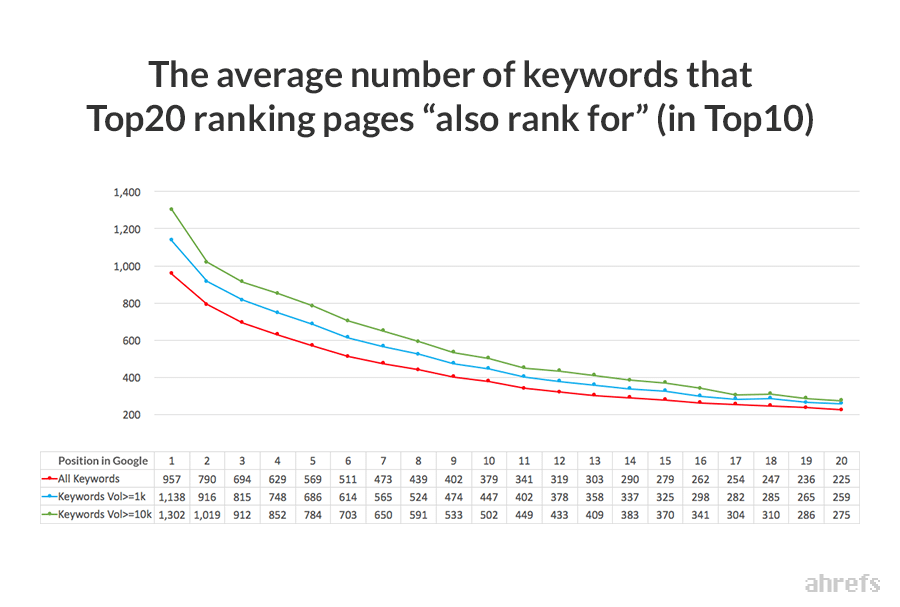
However, we only need to analyze the main variant of the keyword. So, let’s analyze the main keyword “SEO books” using the keyword checklist:
- Keyword Difficulty: As you can see from the SE Ranking keyword research tool, this keyword has a very low difficulty score. This means even my smaller website has a chance of ranking for the keyword.
- Search Volume: As you can see, it’s not as high, but it’s alright in the SEO niche. For me, the search volume is worth the effort if the traffic and business potential are high for my website. Remember if I rank in the top position, the search volume can be much higher.
- Cost-Per-Click: As you can see the CPC is relatively high for this keyword, which shows to me that this keyword has good transactional value.

- Traffic: To see the traffic potential of the keyword I can look at the “Organic search results” section to see the estimated number of clicks the top pages are getting. And as you can see despite the search volume is low, the top-ranking pages are getting over 1,000 traffic visits and ranking for tens and even hundreds of keyword variants. Therefore, this keyword has great traffic potential.

- Business Potential: As I said, this depends on your niche and business. For example, for me, this keyword has excellent business potential because I can include affiliate links to the books I am recommending. However, if you are selling SEO software, then the business potential is lower because you will not add affiliate links. And while you can offer your software and your academy as an alternative to learning SEO but it’s not exactly what the searcher wants. Thus, the potential is lower. However, you’ll never know until you try, right?
- Search Intent: To determine the search intent, I’ll look at the top-ranking pages for the keyword. Looking at the top-ranking pages I can see it is mostly category or listicle blog posts recommending the best SEO books. This means I can match the search intent by creating a blog post as my website does not have product category pages because I am not an eCommerce site. However, both versions can satisfy the intent.

So by looking at this keyword analysis checklist I can definitely say that this keyword is an excellent choice for me I can put it in my spreadsheet.
And like this, you can analyze any keyword you find during keyword research and content gap analysis. Remember analyzing keywords will help you to focus your marketing resources only on the most important and profitable keywords for your business and most likely you will see the best results from your SEO strategy.
And that’s all the steps I have for you to conduct a successful content gap analysis. Once you have enough analyzed keywords, you can start with creating SEO content for your website.
Content Gap Analysis Best Practices
And before we end this, here are some best practices to get the most out of your Content Gap Analysis.
Practice #1: Map Your Content to Your Buyer Journey
The first practice and arguably one of the most important is to map your newly discover keyword ideas to your buyer journey.
One of the biggest mistakes you can make when you are conducting content gap analysis does not have a clear vision of how your newly discovered keyword will fit in your buyer journey.
Just because one of your competitors is targeting the keyword it doesn’t mean the keyword will work for you and it will be driving you leads or sales.
Remember, the goal of targeting keywords is not just about bringing organic traffic but driving qualify organic traffic that has the potential to convert into customers soon or later.
Therefore, the goal of content gap analysis should be finding keywords that will be the go-to content for prospects and customers and if the keyword doesn’t provide new information to the customer to move further in the buyer journey, then the content will be an only liability for you.
So, like with any marketing strategy, you need to know your target audience and their needs and challenges. Only like that you can create truly effective Content Marketing and SEO strategies and enable buyer enablement.
Practice #2: Have Total Overview of Your Website Content Inventory
And the second important practice is to ensure you have done your content inventory audit before you start content gap analysis.
As you have seen, content gap analysis is based on analyzing missing keywords on your website. However, what can also happen is that you are already targeting the keyword and having content, you just won’t rank for it.
Thus, the SEO tool will show that you are missing the keyword and you would be creating another piece of content for the same keyword and end up with cannibalization if you would start ranking for the keyword later on.
Also, SEO tools do not show you all the keywords you are ranking for. Therefore the same thing can happen again if you do not know your content inventory.
So, before you do your keyword research and content gap analysis, ensure you are having a total overview of your website content inventory.
Final Advice
Content Gap Analysis is an advanced keyword research tool and can give you the edge over your competitors. Especially smaller marketing teams can really benefit by using content gap analysis as you can get quick answers.
Therefore, I recommend you create a long list of competitors to conduct your content gap analysis as you can find some really golden keywords to drive more revenue for your business as I did with the keyword “seo books”.
Related Articles:
- What are LSI Keywords and How to Find Them? [Boost Ranking & Organic Traffic]
- How to Do a Content Audit for B2B Website? To Increase Organic Traffic, Leads & Ranking
- Off-Page SEO: Learn Everything You Need to Get Started in 2023
- Ultimate On-Page SEO Guide for Non-SEOs to Boost Organic Traffic & Ranking
- 6 Most Important Google Ranking Signals You Should Know to Improve Your Ranking
- Ultimate SEO Checklist That Actually Works in 2023
- Semantic SEO: Ultimate Guide (2023)
- On-Page SEO vs Off-Page SEO [infographic]
- SEO Keyword Mapping: The Trick to Perfect SEO
Also, check out our SEO hub page to find all our SEO resources.
Disclaimer
Some pictures are coming from Freepik and some of my links are affiliate links, which means if you purchase something, I might get some small commission as a reward for reference. Of course, I am actively using all these services and products, and I only affiliate products or services I have full trust in their quality!








